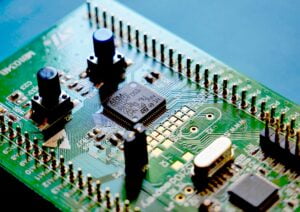Embedded system development is crucial for fields such as the Internet of Things (IoT), smart homes, industrial automation, and medical devices. An embedded system is a specialized computing system that integrates both hardware and software designed to perform specific tasks. This article will introduce the basic concepts of embedded system development, key technologies, commonly used microprocessors, and emerging trends.
Overview of Embedded System Development
An embedded system is a dedicated computing system designed for specific application scenarios, characterized by high real-time performance, reliability, and low power consumption. These systems are widely used in various industries, including consumer electronics, automotive, industrial control, and medical equipment.
Components of an Embedded System
- Processor: The core of the embedded system responsible for executing instructions. Common processors include microcontrollers (MCU) and microprocessors (MPU).
- Memory: Includes Flash, RAM, and ROM, used for storing program code and data.
- Input/Output Devices: Such as sensors, displays, keyboards, and communication interfaces (e.g., UART, SPI, I2C).
- Power Management: Ensures stable power supply under various operating conditions.
- Software: Includes operating systems, drivers, and application software.
Embedded System Development Process
- Requirement Analysis: Define the system's functional and performance requirements.
- System Design: Select hardware components and software architecture, and develop the system design plan.
- Hardware Development: Design circuit boards (PCB), and select appropriate processors and peripherals.
- Software Development: Write drivers, operating systems, and application code.
- Integration and Testing: Integrate hardware and software, conduct functional and performance tests.
- Deployment and Maintenance: Deploy the system and perform ongoing maintenance and upgrades.
Common Microprocessors
Microprocessors are the core components of embedded systems, responsible for executing all computing and control tasks. Below are some commonly used microprocessors and their characteristics:
1. ARM Cortex-M Series
The ARM Cortex-M series is one of the most widely used embedded microprocessors, known for high performance, low power consumption, and ease of development. The series includes Cortex-M0, Cortex-M3, Cortex-M4, and Cortex-M7, suitable for applications ranging from low-power sensor nodes to high-performance industrial controllers.
2. ESP32
The ESP32, developed by Espressif Systems, is a low-power microprocessor with integrated Wi-Fi and Bluetooth capabilities. It is widely used in IoT devices, smart homes, and wearable devices.
3. Raspberry Pi
The Raspberry Pi is an ARM-based single-board computer, popular for its low cost and powerful features. It is used in education, DIY projects, industrial automation, and IoT applications.
4. STM32 Series
The STM32 series, developed by STMicroelectronics, consists of microcontrollers based on the ARM Cortex-M core. They are widely used in industrial control, consumer electronics, and medical devices.
5. AVR Series
The AVR series, developed by Atmel (now part of Microchip Technology), is an 8-bit microcontroller known for its simplicity and reliability. It is widely used in consumer electronics, industrial automation, and education.
Embedded System Development Tools
Development of embedded systems requires various tools, including integrated development environments (IDEs), compilers, debuggers, and simulators. Common tools include:
- Keil MDK: For ARM Cortex-M microcontrollers.
- IAR Embedded Workbench: Supports various microcontrollers with robust debugging capabilities.
- Arduino IDE: An open-source environment suitable for AVR and ESP32 microcontrollers.
- STM32CubeMX: A graphical configuration tool for STM32 microcontrollers.
- PlatformIO: A multi-platform development environment supporting ESP32, STM32, AVR, and more.
Trends in Embedded Systems Development
As technology advances, embedded systems are becoming increasingly widespread across various fields, especially with the integration of artificial intelligence (AI). The following are key trends in embedded systems development, particularly focusing on AI applications.
1. Rise of Edge AI
Edge AI involves moving computational power from the cloud to edge devices close to the data source, reducing latency, bandwidth requirements, and enhancing data privacy. Edge AI can make real-time decisions, suitable for applications like manufacturing, autonomous driving, and medical devices oai_citation:1,The top 6 edge AI trends—as showcased at Embedded World 2024 oai_citation:2,Embedded systems in 2024: Key trends and predictions - Blog Solwit.
2. Tiny AI/ML
Tiny AI/ML refers to small AI models running on resource-constrained devices, performing AI inference tasks locally. This reduces reliance on cloud computing and enhances data privacy oai_citation:3,The top 6 edge AI trends—as showcased at Embedded World 2024. Examples include smart home devices performing voice recognition and image processing directly on the device, and portable health monitoring devices analyzing physiological data in real-time oai_citation:4,The top 6 edge AI trends—as showcased at Embedded World 2024 oai_citation:5,Upcoming Trends in Embedded Systems for 2024.
3. Integration of 5G and Embedded AI
The proliferation of 5G technology brings higher bandwidth and lower latency to embedded systems, enabling real-time data transmission and processing. This drives smart connectivity and collaborative edge computing oai_citation:6,Upcoming Trends in Embedded Systems for 2024. Applications include smart city traffic systems and industrial IoT environments oai_citation:7,Embedded systems in 2024: Key trends and predictions - Blog Solwit.
4. AI-Specific Processors
There is increasing demand for AI-specific processors, such as neural processing units (NPUs), capable of efficiently executing complex AI algorithms. These processors enhance the intelligence of embedded systems oai_citation:8,The top 6 edge AI trends—as showcased at Embedded World 2024. Use cases include drones for real-time image processing and autonomous flight, and wearables for accurate and real-time health monitoring oai_citation:9,Embedded systems in 2024: Key trends and predictions - Blog Solwit.
5. Open Source and Standardization
The widespread use of open-source software and standardized platforms accelerates the development of embedded AI systems. Projects like Zephyr OS and TensorFlow Lite provide developers with a wealth of tools and resources, promoting innovation and adoption of embedded AI applications oai_citation:10,Embedded systems in 2024: Key trends and predictions - Blog Solwit.
The development of embedded systems is undergoing a significant transformation with the integration of AI technology. From edge computing to tiny AI/ML, and 5G integration to AI-specific processors, embedded AI applications are becoming smarter and more efficient. These technological advancements enhance system performance and responsiveness, bringing new application scenarios and business opportunities across various industries. As technology continues to evolve, embedded systems will play a crucial role in driving digital transformation in many fields.

